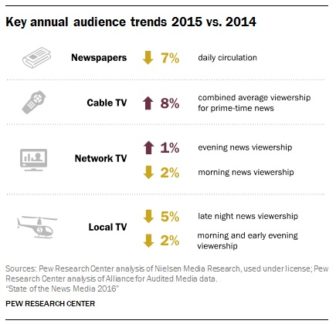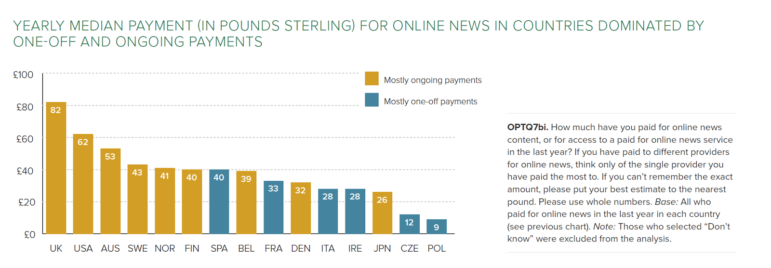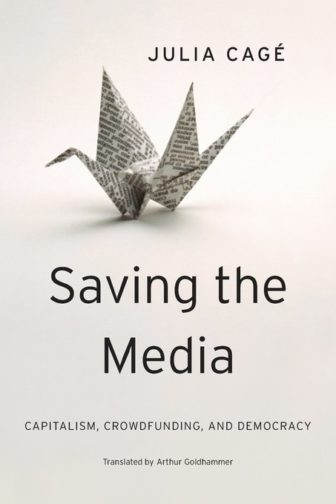 You already know the story well — how the business model for traditional media collapsed in the U.S. (Pew: State of the News Media 2016).
You already know the story well — how the business model for traditional media collapsed in the U.S. (Pew: State of the News Media 2016).
And how digital advertising’s market share surpassed print and will overtake television this year.
And how media organizations have responded by cutting staff and weakening their products in order to keep profit margins high — newspapers eliminated 20,000 jobs in 20 years, a 39% decline in employment.
All of this has been done to serve advertisers and investors at the expense of the most important people in the media equation — the public, the readers, the users. But now publishers are rediscovering the importance of focusing on serving readers.
Readers, Viewers Rule
Now that digital media have broken up that arranged marriage of advertising and news content, publishers are realizing once again that their business is a public service and that the most important people in the equation are not the investors and the advertisers but the public.
This means they have to get most of their revenue in the future from readers. The good news is that readers will pay for online content when it is different and of high quality. Investigative journalism projects online in Spain, Holland and France and the U.S., among other places, are thriving with the help of people who pay not just for news and information but to support a public service.
De Correspondent of Holland and El Español of Spain both got started with million-dollar crowd funding campaigns driven by appeals to a sense of public service. This style of fund raising seems to work best when launching a publication or to fund a special project.
Publishers have to think of recruiting members to a community of shared values rather than selling subscriptions. The public, which has been conditioned to view media as a free or nearly free service, is gradually realizing that they will have to pay for high-quality, trustworthy news and information sources.
While the participation numbers are still low — around 10% on average in 25 countries, according to the Reuters Institute Digital News Report 2016 — people are paying for news and information. The median payment for digital news (see chart below) ranges from $100 annually in the UK, to $75 in the U.S., around $50 in Norway, Finland, Spain, and Belgium, and $32 in Japan.

Loyalty and Confidence
While the old metrics for valuing and pricing media are still used — mass audiences, total users, total page views — they are gradually being replaced by measures of reader loyalty to a media outlet and by reader engagement.
The new metrics of the “attention web” focus is on showing the value of the audience’s relationship with the media brand rather than with an advertiser’s product. Some of these metrics are:
- duration of user’s visits per month
- frequency of visits per day or per month
- time spent on a piece of content
- scrolling through a piece of content (to see if more than the headline was viewed)
- comments made on content
- shares of content through social media
Sponsors, Not Advertisers
Like an advertiser, a sponsor pays for exposure on a news organization’s website. Unlike an advertiser, a sponsor pays not just for the number of eyeballs reached or clicks generated by the online message. Sponsors want to connect their brands with the credibility and values of the news brand.
Of course, a sponsor wants a large audience, but it wants its message seen within the context of the media organization’s trusted content. Sponsors pay for recognition and branding more than generating transactions in the short term, with the hope that the branding generates transactions in the long term.
Publishers are realizing that they need to create community, a feeling among readers that they belong to a kind of club by paying for information that they can’t get anywhere else. And more than that, they need to feel that by paying for this service, they are serving their community.
Investors See Value
This community-service connection has a commercial value as well, as shown by organizations like the Media Development Investment Fund and North Base Media (“Investor sees great returns from new digital media“).
The old business model for news media was based on a monopoly of distribution that served investors with hefty profit margins and advertisers who wanted to reach as big an audience as possible.
The new business model for news media is based on relationships with the members of a community, not necessarily on the size or scale of the community.
 Media researcher Alfonso Vara-Miguel, a colleague at the University of Navarra, writes that obtaining reader loyalty is the most important objective for journalism brands, and that this loyalty translates into economic value:
Media researcher Alfonso Vara-Miguel, a colleague at the University of Navarra, writes that obtaining reader loyalty is the most important objective for journalism brands, and that this loyalty translates into economic value:
“A loyal reader will repeatedly buy their paper, will better tolerate price increases, will be more inclined to buy other products from that brand, and is much more likely to recommend those products to other people . . . In the new digital communication marketplace, the loyalty of audiences is much more relevant than it was in the pre-internet era” (emphasis in the original).
This new kind of relationship with readers creates a big opportunity to generate revenue from events. Texas Tribune generates more than $1 million a year from 50-plus events centered on politics, public affairs, and business.
Events are a way of building a community, strengthening a media brand and gaining financial support in the marketplace for a public service product. In this way, high-quality information is like educational or cultural organizations that compete in the marketplace but are public services.
Hybrid Model
 And while Julia Cagé’s “Saving the Media” sees the main hope for journalism survival in government subsidies, I think a kind of hybrid model with a heavy dose of commercial enterprise is a stronger long-term solution.
And while Julia Cagé’s “Saving the Media” sees the main hope for journalism survival in government subsidies, I think a kind of hybrid model with a heavy dose of commercial enterprise is a stronger long-term solution.
The benefits of developing loyalty, as Vara-Miguel points out, can create other opportunities and partnerships. We have all seen the lists of alternative revenue sources for digital media — packaging data, virtual stores, music, books, artisanal products, travel, consulting, editorial services, and so on. They build on the public’s trust in a media brand and their loyalty to it.
The focus on the reader as the prime source of revenue is healthy in the long term, painful in the short term. It makes us think of that mass of humanity out there more as a community that we serve rather than an audience we sell to.
This post originally appeared on the blog News Entrepreneurs and re-published with the author’s permission.
 James Breiner is a consultant and visiting professor at Spain’s University of Navarra. He is former director of the Global Business Journalism program at China’s Tsinghua University and founding director of the University of Guadalajara’s Center for Digital Journalism. He has worked as publisher, editor, and I-team leader.
James Breiner is a consultant and visiting professor at Spain’s University of Navarra. He is former director of the Global Business Journalism program at China’s Tsinghua University and founding director of the University of Guadalajara’s Center for Digital Journalism. He has worked as publisher, editor, and I-team leader.
